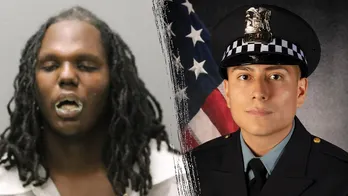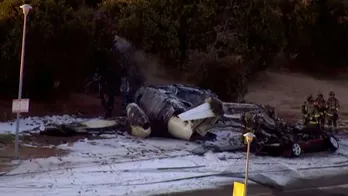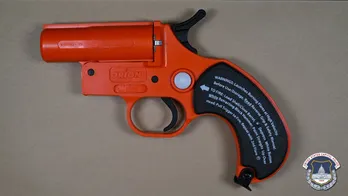The first smart gun with facial and fingerprint recognition is now for sale
In the 2012 film Skyfall, Q presents James Bond with a special handgun for his latest mission — a Walther PPK 9mm short — fitted with a sensor encoded to Bond's palm print so only he can fire it. It's a Hollywood version of a smart gun, a firearm that only an authorized user can unlock and fire.
There's the movies, though, and there's the real world. And in the real world, the technological challenges as well as some political ones have meant that smart guns haven't become a reality.
But that may be about to change because a Colorado start-up called Biofire says it has developed the first biometric smart gun for market. This month, the company began taking pre-orders for the firearm, which uses facial recognition and fingerprint verification.
"The basic premise of a smart gun — a firearm that only works for you — is sort of obvious and uncontroversial," says Biofire's founder and CEO Kai Kloepfer. "The challenge is nobody's ever built one that always works for you and never works for anybody else."
For Kloepfer, 26, it's a journey that began the same year that Skyfall came out — but not because of the tech in the movie. Kloepfer says he began thinking about how technology could improve gun safety after a gunman killed 12 people and wounded dozens more at a midnight screening of a Batman movie in the Denver suburb of Aurora in July that year.
Kloepfer was 15.
A science fair project that became a start up
Kloepfer lived about a half-hour drive from Aurora. He says he knew about gun violence back then, but it had never hit so close to home.
As a kid with an interest in engineering, he wondered whether there was a technological solution that could help tamp down gun violence.
"I settled on a smart gun, which is basically a firearm that's always locked by default but instantly accessible to the user," he says.
Kloepfer got to work trying to engineer one — as a science fair project. It was basically a 3D printed model — it's displayed at Biofire's headquarters — and it looks like a plastic gun with the top half missing. But on the side of the gun grip is his technological leap: a fingerprint sensor.
"As you can tell, it's not actually a gun," he says, pointing to that earliest prototype in the display case. "I wasn't allowed to work on firearms for the science fair. I would have gotten kicked out, actually."
That science fair model barely worked, Kloepfer says. But the engineering and analysis that went into it still won him first place at an international science fair in engineering. (He says he spent some of his prize winnings on a bicycle.)
But he kept tinkering away on his smart gun idea, and with $50,000 in grant money he managed to engineer a new prototype — one that actually fired.
What he did, in essence, was meld a fingerprint sensor onto the grip of a Glock handgun. It was rudimentary and unreliable, he says, but for the most part it worked.
"It was very clear that taking Glocks and buying off-the-shelf firearms and drilling holes in them isn't a good way to build a reliable product," he says.
After a short stint at MIT, Kloepfer dropped out to focus on Biofire, now a company with 40 employees and $30 million in venture capital funding.
His team has designed a built hundreds of prototypes, trying to meld old-school gunsmithing with the latest in cutting edge electronics and doing its research, development and testing at its headquarters outside Denver.
In the main workshop space, there are thermal chambers that simulate different environmental conditions. That sort of testing is critical, Kloepfer says, to ensure that gun loaded with electronics works in any sort of environment.
"We're focused on home defense, but building a firearm that stops working because you took it out back in the rain obviously doesn't work," Kloepfer says. "So we've done a lot of work around testing for super hot environments, super cold environments, what happens when it gets wet or dropped in a puddle or a bucket of water, dropped in the mud."
Biofire's latest model — the one recently made available for pre-order — looks like a regular handgun but one out of a futuristic movie. On the gun grip, there is a small fingerprint sensor right where your middle finger rests when holding the weapon. On the back is a 3D facial recognition sensor.
When someone authorized to use the gun picks it up, green lights on the sight and the back of the weapon turns on, indicating that the firearm recognizes the person and is unlocked. Set it down the gun and the lights turn off.
In a test conducted for NPR at Biofire's in-house firing range, Kloepfer was the only person authorized to use the gun. He picked the weapon up, aimed at a target down range and fired.
He put the gun down and the green light immediately turned off.
When an NPR reporter, who was not an authorized user, picked the gun up, the weapon remained locked and wouldn't fire.
Previous attempts to build a reliable smart gun have failed
Smith & Wesson reached a voluntary agreement the Clinton administration to implement several reforms, including the development of smart guns. But the company shut down its smart gun effort years ago in the face of fierce NRA-led opposition.
The NRA does not oppose smart guns, just anything that would mandate smart gun technology.
And a German company called Armatix brought a gun to market in 2014 that used a radio-frequency watch to unlock the weapon. But it faced technical troubles and political blowback.
This time may be different, says Nick Suplina from the gun control group Everytown. He's seen the Biofire smart gun in action, and he says it does what previous attempts at a smart gun have not: It works.
But he also cautions that smart guns aren't going to end the epidemic of gun violence in America.
"Even if widely introduced, smart guns only solve part of the problem of gun violence in the United States," he says.
One thing they could help with though, he says, is preventing unintentional shootings involving children. In 2022, for example, there were more than 320 unintentional shootings by children in the U.S., resulting in 145 deaths and more injuries, Suplina says.
"Firearms are now a leading cause of death among children and teens," he adds. "A smart gun would prevent a child from successfully firing a weapon that they're not authorized to access. And that's a really promising development."
Smart guns could also help curb accidents and suicides, the latter of which makes up more than half of all gun deaths in the U.S. each year.
For his part, Kloepfer acknowledges that his smart gun wouldn't have prevented the mass shooting in Aurora more than a decade ago that set him down this smart gun path. There are no total solutions, he says.
"My goal is I want to have an incremental positive impact on sort of the uniquely American challenge of gun deaths," he says.
Audio story produced by Lexie Schapitl
Disclaimer: The copyright of this article belongs to the original author. Reposting this article is solely for the purpose of information dissemination and does not constitute any investment advice. If there is any infringement, please contact us immediately. We will make corrections or deletions as necessary. Thank you.







